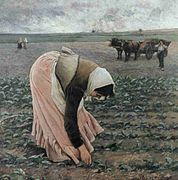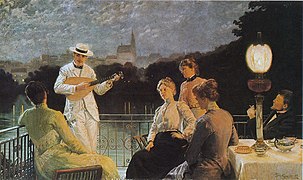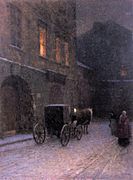Jakub Schikaneder
You can help expand this article with text translated from the corresponding article in Czech. (January 2017) Click [show] for important translation instructions.
|

Jakub Schikaneder (27 February 1855 – 15 November 1924) was a Czech[a] painter and professor.
Biography
[edit]Jakub (or Jakob) Schikaneder was born on 27 February 1855 in Prague, Austria-Hungary to an Austrian German father and a Czech mother. His father, Karel Friedrich Schikaneder, was from Vienna and worked as a customs office clerk in Prague. His mother Leokadia (née Běhavé) was a native of Prague. He was a paternal descendant of Urban Schikaneder, the elder brother of librettist Emanuel Schikaneder.[1]
The Schikaneder family's love of art enabled him to pursue his studies at the Academy of Fine Arts from the age of 15 despite their poor economic circumstances. A year later, they were further impoverished when his father died. Schikaneder was a student of Antonín Lhota at the Academy and finished his studies in 1878, serving for a year in the Austro-Hungarian Army. He travelled to Paris before continuing his studies in Munich under Gabriel von Max.[2] He counted amongst those who admired the Munich School of the end of the 19th century.[1] Schikaneder returned to Prague where, along with Emanuel Krescenc Liška, he was involved in the furnishing of the royal box in the National Theatre. However, this work was lost in a fire in 1881. Following his work in the National Theatre, he traveled through Europe, visiting Germany, England, Scotland, The Netherlands, Switzerland, Italy and France.
On 5 July 1884, Schikaneder married Emília Nevolová, daughter of a railway official. They lived in the Vinohrady district of Prague and had one child who died in infancy. Around this time, Schikaneder became an assistant in the studio of František Ženíšek at the Academy of Arts. From 1891 to 1922, he taught at the Academy of Arts, becoming professor in the studio of decorative painting. In 1913, he was elected a full member of the Academy of Sciences and Arts. Following his retirement from teaching in 1922, Schikaneder repeatedly visited the island of Heligoland in Germany.
Schikaneder died on 15 November 1924 in Prague and was buried in Vinohrady Cemetery.[3]
Work
[edit]Schikaneder is known for his soft paintings of the outdoors, often lonely in mood. His paintings often feature poor and outcast figures and "combined neo-romantic and naturalist impulses."[4] Other motifs favoured by Schikaneder were autumn and winter, corners and alleyways in the city of Prague and the banks of the Vltava – often in the early evening light, or cloaked in mist. His first well-known work was the monumental painting Repentance of the Lollards (2.5m × 4m) which has since been lost. The National Gallery in Prague held an exhibition of his paintings from May 1998 until January 1999.
Selected works
[edit]-
The Sad Way, 1886/87
-
Weeder, 1887
-
Company on the Terrace, 1887
-
All Soul's Day, 1888
-
Murder in the House, 1890
-
Evening Street, 1906
-
Evening in the Garden, 1907–09
-
A Corner of Old Prague, 1900–1905
Notes
[edit]- ^ Schikaneder was a citizen of Austria-Hungary from 1855 to 1918 and then Czechoslovakia from 1918 to 1924. He was lifelong resident of the Kingdom of Bohemia and his mother was Czech.
References
[edit]- ^ a b "Artist Biography & Facts: Jakob Schikaneder". askART. Retrieved 26 July 2022.
- ^ László, Péter (1988). Intellectuals and the Future in the Habsburg Monarchy 1890-1914. Palgrave Macmillan. p. 143. ISBN 9781349191697.
- ^ Vinohrady Cemeteries, MyCzechRepublic.com, retrieved 20 November 2013
- ^ Zusi, Peter (2006). "'Wie ein Kind ist unser Volk': Hybrid Identity and National Consciousness in Rilke's 'Zwei Prager Geschichten'". The German Quarterly. 79 (3): 329–346. doi:10.1111/j.1756-1183.2006.tb00047.x. JSTOR 27675954.
Further reading
[edit]- Tomáš Vlček: Schikaneder: Jakub Schikaneder, Prague painter of the turn of the century ("A thematic guide to a retrospective exhibition, National Gallery in Prague, Collection of Old Masters, Wallenstein Riding School in Prague, May 15, 1998 – January 10, 1999"). Prague: National Gallery, 1998.
External links
[edit]- (in French) Radio Prague – extensive Biography
- Exhibition titled "Jakub Schikaneder: Master of moods and melancholic poetry" at Adolf Loos Apartment and Gallery








